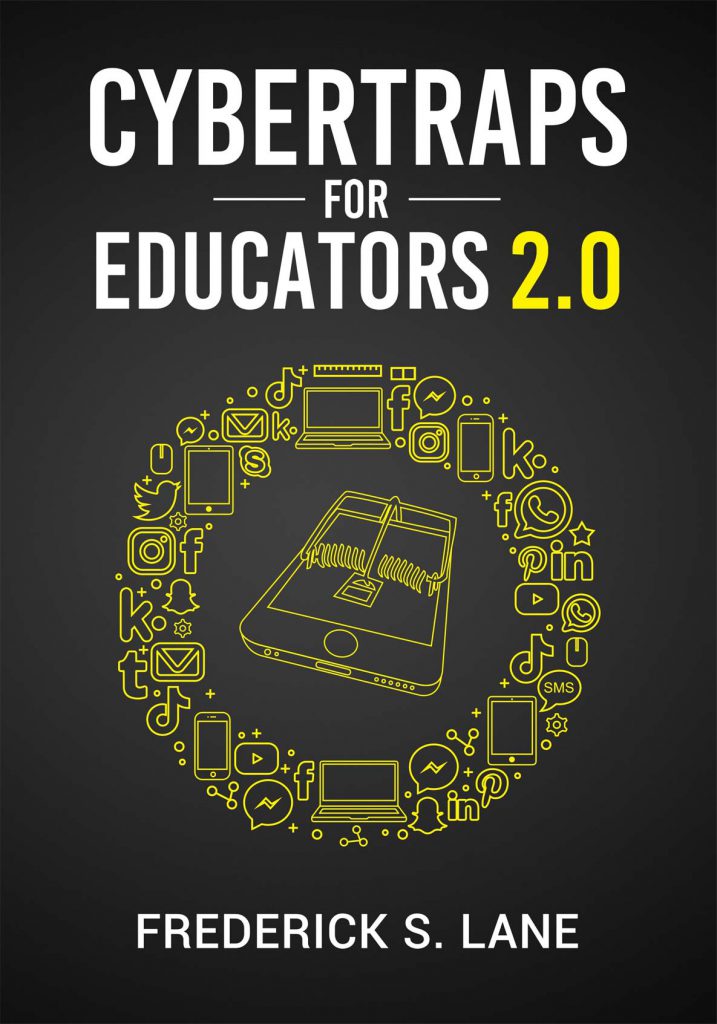
"Cybertraps for Educators 2.0 is unsurpassed in its treatment of the use of electronic media by educators."
David P. Thompson, Ph.D., Professor of Educational Leadership & Policy Studies, The University of Texas at San Antonio
CyberTraps for Educators 2.0
A guide for teachers, administrators, and school districts on how to minimize the risks arising from the use and misuse of digital devices.
Mobile devices and social media have changed all of our lives, but no profession has been quite as affected as teaching. It’s not just the challenge of incorporating technology into the classroom; it’s how digital communication tools have changed the relationship of teachers with the school communities they serve. Cybertraps for Educators 2.0 is a detailed look at those changes and the risks posed to both educators and students.
Every single week, a teacher or school administrator somewhere in the United States is fired for something they said on social media. More and more school districts face litigation arising out of smartphone-abetted sexual assault cases. Teachers are surrounded every day by young investigative reporters carrying sophisticated recording devices connected to global distribution platforms. And now, thanks to the worldwide pandemic, more and more education is occurring online — with enormous implications for educator privacy, student-teacher relationships, and professional ethics.
Cybertraps for Educators 2.0 is the guide that administrators and teachers need to avoid the potentially career-ending mishaps that can result from the use and misuse of digital devices. Using contemporary case studies, this timely book illustrates the pitfalls of technology and offers practical advice on how teachers, administrators, and school districts can minimize the risks of misconduct.
Throughout the book, author Frederick Lane weaves in principles and standards drawn from the Model Code of Ethics for Educators (MCEE). The MCEE was promulgated by the National Association of State Directors of Teacher Education and Certification (NASDTEC) in 2015 and is the first attempt to develop a national code of ethics for educators. Lane’s innovative book, Cybertraps for Educators 2.0, is the first to apply the MCEE to major issues facing the teaching profession.
About the Book
What People Are Saying
What's In the Book

The Model Code of Ethics for Educators contains five core principles. Only one, Principle V, deals explicitly with an educator’s ethical use of technology. However, as we are all well aware, technology and digital communications are woven into every aspect of our lives. It is not surprising, then, that your use of technology plays a role in your ability to adhere to many, if not most, of the ethical standards listed in the first four principles of the MCEE.
Besides discussing the possible implications of technology use to Principles I through IV in the chapters below, I also include potentially relevant standards from those initial Principles at the end of each cybertrap chapter.
In the second section of the book, I review some specific cybertraps that educators and administrators face due to their private use of technology. In general, these cybertraps do not involve direct interaction with students, which is where the most serious concerns arise. Most of the privacy cybertraps occur because of choices educators make in their personal lives and their enthusiasm for documenting those choices with mobile devices or on social media.
The central point of this section of the book is that maintaining actual privacy (i.e., the ability to control access to and use of personal information) is exceedingly difficult if you digitize that information. The phrase “information wants to be free” appears multiple times in this book for a good reason; once data is stored digitally, it has an almost organic compulsion to spread. Replication and distribution of information are at the very core of the internet’s design, so this should not come as a surprise. But far too often, as these cybertraps illustrate, people get unpleasant reminders of just how easily private content can become public.
The easy spread of information is relevant to educators because it changes the dynamic of serving as a role model. Before social media, a school community would have minimal opportunity to sit in judgment of how a teacher behaved in the privacy of his or her home unless something unusual happened (like an arrest). Today, however, far too many educators live their lives in front of multiple tiny windows. It should not come as a shock when students and parents peer through those windows and react to what they see.
When we leave the outside world and move into the classroom, the use of digital technology by educators immediately gets dicier. Now, you are no longer responsible merely for your privacy but that of your students as well. You are also spending hours each day interacting with large numbers of technically-skilled teens and pre-teens, many of whom lack the judgment and impulse control required by such powerful devices.
The level of community and administrator scrutiny rises as well. Parents understandably want educators to behave appropriately, set a good example, and treat their children well. Mobile technology makes it much, much more straightforward for parents and guardians to “observe” what is taking place in the classroom.
In a polarized nation undergoing several fraught crises, the proliferation of mobile devices among students is a persistent headache for administrators. Controversial actions by teachers (poorly thought-out homework assignments, for instance) can create a social media firestorm. No school board member wants large hostile crowds showing up for public comment, and no administrator wants the nightmare of fielding death threats at district headquarters. More than anything else, this section underscores the degree to which technology is a classic double-edged sword: a wonderfully powerful educational resource that can easily be misused.
For obvious reasons, the Cautionary Tales in this section are the ones that garner the most headlines. That makes sense; anything that threatens the health and safety of students is inherently newsworthy. As much as possible, I have tried to avoid sensationalism and prurience when selecting these tales. While the substance of some of these stories is difficult to absorb, they are actual events, and we need to understand how and why they occurred.
Most readers will correctly reassure themselves that they would never engage in the types of conduct that I describe. Numerically, at least, that is correct. Only a tiny percentage of educators engage in behavior severe enough to merit criminal charges. But most of us can understand at least some of the feelings and emotions that contribute to these crimes: stress, depression, addiction, loneliness, desire, lust, etc. More importantly, virtually all of us use the devices and the communication tools that appear in the criminal cautionary tales. I refer collectively to these incidents as “cybertraps” for a particular reason: anyone who is incautious or unwary can find themselves snared. One of the main objectives of the Model Code of Ethics for Educators is to enhance our ethical muscle memory to make entrapment less likely.
In the Conclusion, I offer some ideas and suggestions for how educators and administrators can address the issues that I discuss in this book. Each of us is responsible for how we use technology; if we commit crimes or act unethically, that is not the fault of our employer. However, school districts and individual schools have powerful incentives to help educators and staff avoid cybertraps. As you’ll see repeated throughout this book, the goal is to create a culture of cybersafety that can protect both students and educators.
With the kind permission of the National Association of State Directors of Teacher Education and Certification, I have reproduced the Model Code of Ethics for Educators (MCEE) in the Appendix.
Media

I am an author, attorney, expert witness, and professional speaker on the legal and cultural implications of emerging technology. My main areas of concentration are educator cyberethics, digital safety, privacy, cybersecurity, ethics, and law.
Following my graduation from Amherst College (1985) and Boston College Law School (1988), I clerked for two years for the Honorable Frank H. Freedman, Chief Judge of the U.S. District Court in Massachusetts. After practicing law for five years and writing my first book, Vermont Jury Instructions—Civil and Criminal [with John Dinse and Ritchie Berger] (Butterworths 1993), I launched a computer consulting business that in turn led to my current work as an author, lecturer, and computer forensics expert.
In response to the passage of the Communications Decency Act in 1996, I began researching the legislative and media response to the rise of the online adult industry. The resulting book, Obscene Profits: The Entrepreneurs of Pornography in the Cyber Age (Routledge, 2000), was the first of what are now ten mainstream non-fiction books. The others are:
About the Author
- The Naked Employee: How Technology Is Compromising Workplace Privacy (Amazon, 2003);
- The Decency Wars: The Campaign to Cleanse American Culture (Prometheus Books, 2006);
- The Court and the Cross: The Religious Right’s Crusade to Reshape the Supreme Court (Beacon Press, 2008);
- American Privacy: The 400-Year History of Our Most Contested Right (Beacon Press, 2010);
- Cybertraps for the Young (NTI Upstream, 2011);
- Cybertraps for Educators (Mathom Press, 2015);
- Cybertraps for Expecting Moms & Dads (Mathom Press, 2018);
- Raising Cyberethical Kids: How a Family Acceptable Use Policy Can Make Your Young Digital Citizens Smarter, Safer, Kinder, and More Empathetic (Mathom Press, 2020); and most recently,
- Cybertraps for Educators 2.0 (Mathom Press, 2020).
- I have also written numerous magazine and newspaper articles on a wide variety of topics, including constitutional rights (particularly freedom of speech), privacy online and in the workplace, the impact of technology on our rights and liberties, and the separation of church and state.
- On August 23, 2006, I had the honor of appearing on “The Daily Show with Jon Stewart” to discuss The Decency Wars: The Campaign to Cleanse American Culture. I have also appeared as a guest on a variety of other national television programs, including ABC’s “Good Morning America Weekend,” NBC’s “Weekend Today,” ABC’s “Nightline,” CBS’s “60 Minutes,” and various BBC documentaries. In addition to those televised appearances, I have been interviewed by numerous radio shows, magazines, and newspapers around the world on topics relating to my books.
- Over the last fifteen years, I have frequently lectured to college, university, and professional audiences across the United States and in Canada and China on topics related to my books, including educator misconduct, student online safety, internet technology, workplace and personal privacy, computer forensics, free speech, and censorship. For my information about my lectures and professional services, please free to contact me through one of the following channels.
- Copyright © 2020 Frederick S. Lane All Rights Reserved.